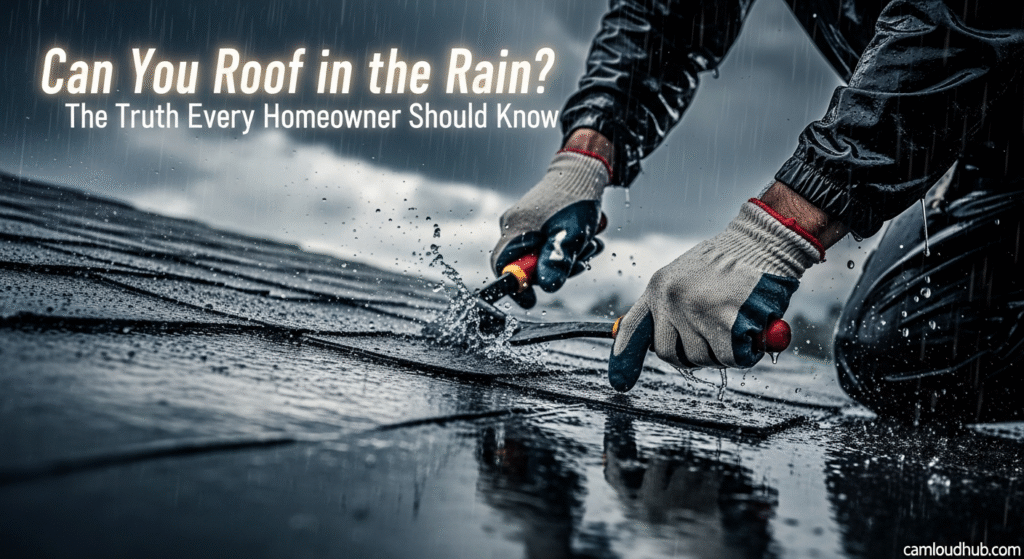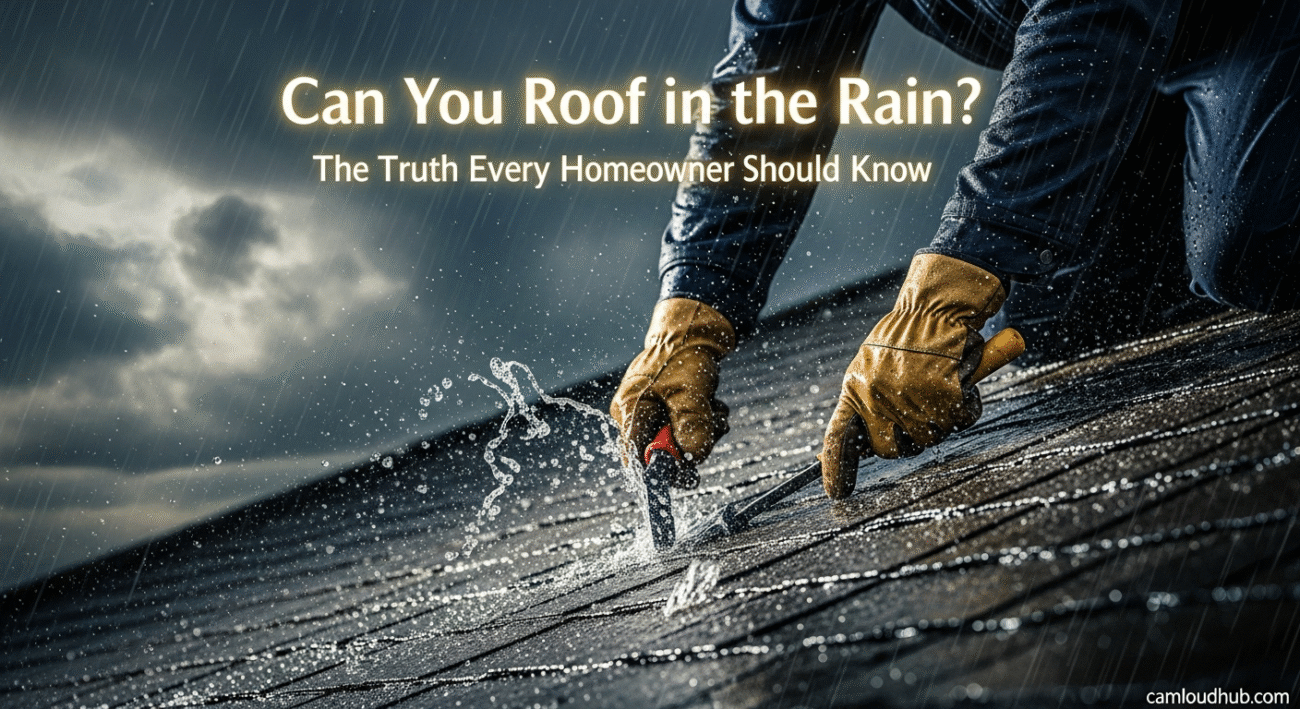The Immediate Dangers: Why Common Sense Says “No”
Can You Roof in the Rain? The Truth Every Homeowner Should Know – When you imagine a construction site, you likely picture sunny skies and busy workers. Roofing in the rain definitely doesn’t fit that idyllic image. The most immediate and obvious reason why experts advise against it is safety. A wet roof surface transforms into an incredibly hazardous environment, posing significant risks to anyone working on it.
Beyond personal safety, the integrity of the materials and the overall quality of the installation are severely compromised. Water can interfere with adhesives, underlayment, and even the basic wood decking. Therefore, starting a full roof installation when rain is falling is generally a very bad idea. It’s often outright forbidden by professional roofing companies due to these inherent risks.

When the Clouds Gather: The Reality of Emergency Repairs
While a full re-roof during a downpour is a definite no-go, there are scenarios where some work must happen when it’s wet. Think about an active leak that’s literally dripping into your living room. In these emergency situations, the focus shifts from a perfect, long-term installation to immediate damage control. This is a critical distinction to grasp.
Emergency patches and temporary solutions are often deployed to mitigate further water intrusion. These are not about fully installing a new roof in the rain. Instead, they’re about buying time until proper roofing in the rain is not needed, and the weather clears up for a permanent fix. This crucial difference often confuses homeowners.
Safety First: A Non-Negotiable Principle
Safety should always be the absolute top priority on any job site. This principle is especially paramount when you’re dealing with elevated work surfaces like a roof. Performing roofing in the rain exponentially increases the danger factor for workers. Wet shingles become incredibly slippery, much like walking on ice.
A misstep can lead to severe falls, causing serious injuries or worse. Furthermore, general construction tools operate on electricity. Combining electrical equipment with water significantly raises the risk of electrocution, a terrifying prospect. Reduced visibility due to rain, fog, or even low light conditions also makes precise work difficult and unsafe. These factors collectively make roofing in the rain a non-starter for responsible contractors.
Material Matters: How Rain Affects Shingles, Underlayment, and Adhesives
It’s not just about the safety of the crew; the materials themselves hate the rain. Asphalt shingles, for example, rely on proper adhesion to the layers beneath and to each other. This adhesion is activated by the sun’s heat, effectively sealing the roof. When you attempt roofing in the rain, moisture prevents this vital sealing process from occurring properly.
The underlayment, which serves as a secondary barrier against water, can also suffer. Some types of underlayment can wrinkle or tear if they get excessively wet before the top layer of shingles is installed. Moreover, flashing and sealants, essential for waterproofing critical areas, cannot bond or cure effectively when surfaces are damp. Applying materials to a wet roof deck can even trap moisture underneath, leading to silent, long-term damage like rot or mold.
The Long-Term Consequences of Wet Installations
Ignoring the dangers and choosing to proceed with roofing in the rain can lead to significant headaches down the road. The immediate problems are often just the tip of the iceberg. A roof installed during wet conditions is inherently compromised from day one. Its structural integrity can be weakened, leading to premature failure.
The lifespan of your roof will undoubtedly be shortened. Rather than lasting for the estimated 20-30 years, you might see issues emerging within a fraction of that time. Hidden moisture, trapped during the installation process, creates an ideal breeding ground for mold, mildew, and wood rot within your roof deck and attic. This can spread, impacting the very structure of your home. To make matters worse, many manufacturers’ warranties explicitly state that their product must be installed in dry conditions. Therefore, roofing in the rain could void your warranty, leaving you financially exposed if problems arise.
The “Gray” Areas: Nuances and Exceptions
So, we’ve established that a full-blown re-roof during a heavy downpour is a terrible idea. However, like most things, there are nuances. Not all rain is created equal, and not all “work on the roof” constitutes a full installation. There are specific circumstances where some activity might occur, or where careful planning can circumvent the worst effects of wet weather. Understanding these “gray areas” is key.
This doesn’t mean roofing in the rain for a new roof is suddenly okay. It means discerning between different types of weather and different stages of a roofing project. A professional roofer knows these distinctions well and will always prioritize safety and quality. They won’t cut corners that could lead to future problems for your home.
Drizzle vs. Downpour: Understanding the Levels of Risk
There’s a vast difference between a light, misty drizzle and a torrential downpour. Most experienced roofers can work during a very light drizzle, provided the roof surface isn’t becoming slippery. However, any amount of rain that makes the surface slick, reduces visibility, or could compromise materials, will halt work. This is where professional judgment comes into play.
A good contractor will always err on the side of caution. They monitor local weather forecasts meticulously, sometimes even delaying a project for hours or days to ensure optimal conditions. They understand that while a client might be eager to complete the job, rushing it by roofing in the rain is never worth the risk. It’s better to wait for dry conditions than to face the expensive and dangerous repercussions of a faulty installation.
Dry-In vs. Full Installation: A Critical Distinction
This is perhaps the most important “gray area” to understand. “Drying in” a roof refers to the process of installing the underlayment and making the roof structure watertight, even if the final shingles or roofing material aren’t yet in place. This is a common practice when a roof deck is exposed during a tear-off. If a storm is approaching, roofers will often race to get the underlayment installed.
This protects your home from immediate water damage, creating a temporary weather seal. However, this is distinct from roofing in the rain with the final capping materials. The underlayment provides protection, allowing the roofers to return when conditions are dry to lay the actual shingles or tiles. It’s a strategic move to prevent water intrusion, not a complete roofing job in adverse weather.
The Role of Underlayment in Wet Conditions
Underlayment, often made from synthetic materials or asphalt-saturated felt, acts as a crucial secondary barrier. It’s installed directly on the roof deck, beneath the final roofing material. During a “dry-in” process, this underlayment is what protects your home from rain if the weather unexpectedly turns. While some underlayments are designed to withstand temporary exposure to moisture, they are not meant to be submerged or constantly wet during a lengthy installation process.
Relying solely on underlayment as a long-term solution is not advisable. It’s a temporary shield. Therefore, while roofing in the rain by installing underlayment might happen to quickly button up a partially exposed roof, it’s always followed by proper installation of the final product when conditions are completely dry. The quality of this base layer is critical, even if it eventually gets covered.
Flashing and Sealants: The Achilles’ Heel in Any Weather
Flashing and sealants are probably the unsung heroes of a leak-proof roof. These highly critical components are carefully installed around chimneys, skylights, vents, and valleys—anywhere the roof changes plane or penetrates the surface. Their job is to divert water away from vulnerble areas. The effectiveness of flashing and sealants hinges entirely on proper installation and adhesion.
Applying sealants or installing metal flashing on wet or damp surfaces severely compromises their ability to bond correctly. Water can prevent the sealant from curing, leading to gaps or weak points. If you attempt roofing in the rain in these critical areas, you’re practically guaranteeing a future leak. Even a tiny, almost invisible gap can allow water to infiltrate over time, causing significant damage. This meticulous work demands dry, clean surfaces to be truly effective.

Professional Best Practices and What to Expect from Your Roofer
A professional roofer understands the complexities of nature and will prioritize your home’s long-term protection. Instead of attempting roofing in the rain, they employ a range of best practices. First and foremost, meticulous pre-planning and continuous weather monitoring are standard. Top contractors will have backup plans in place.
They communicate openly and honestly with homeowners about potential weather delays. If rain is expected, they might postpone the tear-off of the old roof, or they might rush to “dry-in” a partially exposed deck. They also protect the job site, including gardens and driveways, from debris and potential contaminants. A trustworthy contractor will use high-quality materials and ensure every single step of the installation is done under optimal conditions, never sacrificing quality by pushing ahead with roofing in the rain.
You should expect your roofer to clearly explain why work might be paused or delayed due to weather. They are protecting their crew, your investment, and their reputation. If a roofer seems overly eager to press on despite adverse weather, that’s a major red flag. Always choose a company that values safety and quality workmanship above all else. They understand that rushing a job by roofing in the rain is not a shortcut to customer satisfaction, but a direct route to future problems.
Conclusion
So, can you roof in the rain? The definitive answer, particularly for a complete new roof installation, is a resounding no. While emergency patches can be applied to temporarily mitigate leaks and underlayment can be rapidly installed to “dry-in” an exposed roof deck, the actual process of laying down shingles and ensuring a long-lasting, watertight seal absolutely requires dry conditions. Roofing in the rain presents unacceptable risks to workers and severely compromises the quality and lifespan of your entire roofing system.
As a homeowner, your best course of action is to partner with a reputable roofing contractor. These professionals understand the delicate balance between project timelines and the non-negotiable demands of weather. They know that patience, planning, and adherence to best practices are the cornerstones of a successful roof installation. Don’t let anyone convince you that roofing in the rain is a viable option for a quality, durable roof. Prioritize safety, material integrity, and long-term protection, even if it means waiting for the skies to clear. Your home, and your wallet, will thank you in the long run.


